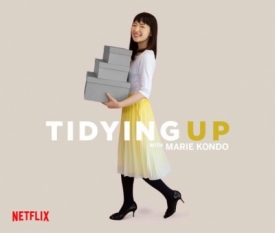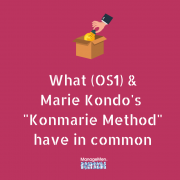(OS1): What a Professional Cleaning Operation Uses to “Tidy Up”
There’s a pretty good chance that over the past month, you’ve heard the name “Marie Kondo” or even watched one of her shows. Named one of Time magazine’s “100 Most Influential People,” Japan’s queen of decluttering has found her way into millions of U.S. home by sharing her way of cleaning or, “tidying up,” those items that do not “spark joy” in their lives. From her two best-selling books to her recent Netflix series, “Tidying Up with Marie Kondo,” she provides organizational guidance to help people create order using her patented “konmarie method.”
In her book “The Life-Changing Magic of Tidying Up,” Kondo discusses how tidying up— much like cleaning — is a self-taught exercise.

“The general assumption, in Japan at least, is that tidying up doesn’t need to be taught but rather is picked up naturally,” she says. “Cooking skills and recipes are passed down as family traditions…yet no one hears of anyone passing on the family secrets of tidying, even within the same household.”
“Instruction in tidying is neglected not only in the home but also at school,” she continues. “When we think back to our home economics classes, most of us remember making hamburgers or learning how to use a sewing machine to make an apron…surprisingly little time is devoted to the subject of tidying.”
It doesn’t take much looking to see the parallels between our industry, the professional cleaning and hygiene industry, and how Kondo has built her empire. She’s found a way for people to find order and develop a system for “maintaining” their home, just as a cleaning operation is designed to do within a commercial building, such as a school, hospital or office.
Similar to the “tidying up” movement, a lot of people in the professional cleaning industry are self-taught because we also operate on the notion that cleaning is a skill that is picked up naturally or through experience.
Like Kondo, our founder, John Walker, recognized the issue with this approach. Because people lacked the proper training, they were not often able to truly clean in a way that led to cleaner, safer and healthier facilities. That’s why he developed (OS1), a scientifically engineered approach to cleaning. This system helps provide a system for cleaning and maintaining a building.
Let’s look at the similarities between Marie Kondo’s approach to tidying up and the (OS1) approach to cleaning:
| Marie Kondo’s Approach | (OS1) Approach |
| Visit a home and consult with the customer about their goals and objectives. | Meet with the client to discuss current program and objectives for implementing a new custodial system |
| Conduct an audit/inventory of the home’s material possessions | Conduct a baseline audit of the custodial program. This includes: inventory of custodial supplies & equipment; observations of cleaning processes; detailed cost analysis of labor/product usage; training and education program; scheduled cleaning services; and HAZCOM risk assessment. |
| Teach the KonMarie method | Teach the (OS1) process through events like Janitor University, Train the Trainer, (OS1) Boot Camp and (OS1) specialist certifications. |
| Help clients understand that tidying up is not a chore but a mindset. | Help custodial operations understand the importance of janitors and that they be treated as first-class citizens. |
| Work with homeowners to implement the KonMarie method and begin purging the home of unnecessary material items | Set up a pilot building within the facility to begin rolling out the (OS1) system. |
| Roll out the Konmarie method over the next month | Continue tactically rolling out the (OS1) system based upon a successful pilot. Create repeatable outcomes and over the next several months/years scale to additional buildings within the operation. |
| Follow-up with client | Ongoing benchmarking of best practices with other (OS1) users through an annual symposium. Participate in annual progress audits to document milestones, troubleshoot issues. |
Take a look at your custodial closet. Is it filled bottles of cleaning chemicals made by companies that aren’t even in business anymore? Do you have pieces of broken equipment collecting dust in the corner? Do you know what tasks are being performed every single day? Do you spend your day handling complaints and putting out fires? Is your staff’s morale perpetually low?
If so, it could mean your custodial department is ready for a little tidying up too.



